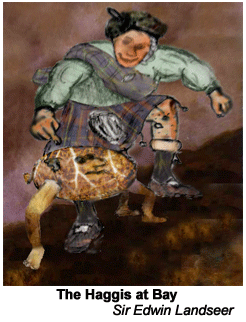|
|
|
January 25th being that great annual Scottish celebration and, to be honest, whisky-fest of Burns Nicht and I myself, in addition, being an Anglo-Scottish half-breed (or as I like to put it a 'Sesqui-scot'1) I can hardly let the one pass without having the other comment on the event, and, since we here at the studio are so strongly against stereotyping, particularly to comment on that non-alcoholic essential for the celebration. I refer, of course, to the haggis.
It is, as I understand it, almost impossible to obtain a real haggis over here and Americans have very little experience with them, so as a public service, and on the off-chance that some of you happen to visit the Highlands of Scotland before you manage to forget this essay, I'll tell you the story of how to catch real haggis.
As you no doubt are aware the haggis, Scotland's national bird, is a carnivorous tripod of the order isoscelesae comprising two species, Haggis sinistris and Haggis dexter. In form it is uniquely developed for its habitat on the steep sides of the rolling mountains of the Highlands of Scotland, in that two of its legs are considerably shorter than the third or downhill leg2. This facilitates rapid and stable progress around its chosen mountain. Haggis sinistris proceeds clockwise and Haggis dexter of course anticlockwise. This, by the way, explains their speciation as there is very little intercourse between the two directions.
Thus in the contentment of perfect adaptation the Haggises progress throughout the year, summer and winter, clockwise and anticlockwise, until the day of the haggis hunt. Early in haggis-morn, after a frugal breakfast of parritch3 and salt the guidman cuts himself a stout stick and, leaving his wee wifie and the wains (well supplied with coarse hempen sacks) at the foot of the ancestral hill, he ascends into the mist, his kilt weighted down with small rocks like an Australian's hat as a precaution against the rogue or jumping haggis. After a vigorous climb he reaches the haggis-line (well above the tree line, not that there are many trees in evidence here) and begins his search. Here it is that stealth, or in fact down-right sneakiness are at a premium, as are good eysight, heather scented aftershave and plenty of patience.
 At last oor guidman glimpses a vague hummock through the mist---the excitement begins, and you should note that it is now that the real skill of the experienced hunter comes into play, for he must decide in an instant whether he is dealing with a clockwise haggis or its counter rotationary antiparticle. His course chosen he quietly sneaks up on his quarry from behind (this is where he parts company with the English hunter who could never be so unsporting---which is why the English have never really accepted the haggis). The guidman then taps his quarry smartly on the shoulder and here you'll at once realise that the essence of a great haggis hunter is that he does this on the shoulder on its downhill side. This act has the immediate effect of rousing the curiosity of the haggis, and as you might expect, it turns round to see who on earth it is, unavoidably being forced to pivot on its long leg. This in turn places the beast in the position of having its short legs on the down side of the slope. And this is of course an eventually untenable position, which it can sustain but for a moment before rolling down the mountain to the feet of the waiting wifie and wains. These quickly stuff the dazed and dizzy haggis into their sacks. At last oor guidman glimpses a vague hummock through the mist---the excitement begins, and you should note that it is now that the real skill of the experienced hunter comes into play, for he must decide in an instant whether he is dealing with a clockwise haggis or its counter rotationary antiparticle. His course chosen he quietly sneaks up on his quarry from behind (this is where he parts company with the English hunter who could never be so unsporting---which is why the English have never really accepted the haggis). The guidman then taps his quarry smartly on the shoulder and here you'll at once realise that the essence of a great haggis hunter is that he does this on the shoulder on its downhill side. This act has the immediate effect of rousing the curiosity of the haggis, and as you might expect, it turns round to see who on earth it is, unavoidably being forced to pivot on its long leg. This in turn places the beast in the position of having its short legs on the down side of the slope. And this is of course an eventually untenable position, which it can sustain but for a moment before rolling down the mountain to the feet of the waiting wifie and wains. These quickly stuff the dazed and dizzy haggis into their sacks.
And we can retire from the scene assured that the family will now have food for the Burns' Nicht feast and all the makings of bagpipes.
And as the Great Rabbie Burns himself once said:
An it's Hey for hochmagandy for now
from Richard Howland-Bolton
|
Notes:
Since the mid-1970s the Haggis has been protected under the Endangering Species Act, with strict (and very limited) limits placed on hunting, and then only by native crofters who are themselves nearly extinct. This means that the only Haggis available on the market is now ersatz: however still on Burns Nicht to maintain the ancient traditions, one of these substitutes is ceremoniously piped in to the dining room whilst all about salute it with toasts of a 'wee dram'; and then, since they are now made out of a sheep's stomach crammed with all sorts of vile, offal things, immediately and with much less ceremony piped out again accompanied with toasts of a not-so-wee dram, lest they spoil the appetites of the diners.
Should you be foolish enough to desire a (for want of a better word) taste here is an old recipe.
1 "... Sesqui-Scot" Ahh! the perils of the half-breed!
I am clearly either a Scot and a half or an Englishman and a half, the logic being as follows:---
Each of my parents insists, following ancient tradition, that one of their race is equal to any two of the other.
Thus my composition is either:
one half English plus one half Scottish times two, totalling 1.5
or
one half Scottish plus one half English times two, totalling 1.5
Hence a Sesqui-Scot since that flows so much better than *Sesqui-Englishman. 2"... downhill leg." One of the most cogent arguments against Intelligent Design is this arrangement of the Haggis's legs since an Intelligent Designer would have realised that having two long legs on the downhill side is considerably more stable*. This is, interestingly, a strong argument against Darwinian evolution too, since this instability should result in strong selective pressure against the observed jambenation**. 3 "... parritch" porridge (noun), formerly frequently treated as a plural, the dish of oats boiled in salted water.
Some say porridge should only be stirred in a clockwise direction using the right hand to avoid attracting the attention of the Devil. The stirring to be done with a straight wooden spoon or stick without a moulded or flat end and known is Scotland as a 'Spurtle' or 'Theevil'.
Porridge should always be spoken of as 'they' and old custom states that it should be eaten standing up. A bone spoon should always be used for eating porridge.
Oats being as Dr Johnson defines them:

__________________
* This does not, we hasten to add, add up to an argument against Really-Stupid Design nor indeed Rather-Weird-Sense-of-Humour Design. ** Well you try to find a word that means 'the arrangement of a given number of legs on a body'.
|
 |
 |
<-- Go Back |
|
|

| Home | Essays | Notes | Gallery | Miscellany | Contact |
All contents including writing, cartooning, music, and photography unless otherwise specified are
copyright © 1965-2023 howlandbolton.com and Richard Howland-Bolton. All Rights Reserved.
All logos and trademarks on this site are property of their respective owners. | Web work* by 
*as distinct from Wetwork
  |
|
|

